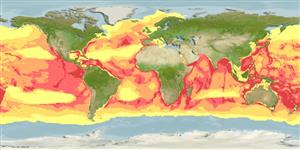Common names from other countries
Environment: milieu / climate zone / depth range / distribution range
Écologie
Pélagique; non migrateur (Ref. 75906); profondeur 0 - 1989 m (Ref. 116169). Tropical; 90°N - 90°S, 180°W - 180°E
Indo-Pacific, Atlantic Ocean and the Mediterranean. Tropical to warm temperate zones.
Length at first maturity / Taille / Poids / Âge
Maturity: Lm ?, range 210 - 220 cm Max length : 270 cm TL mâle / non sexé; (Ref. 1394); poids max. publié: 210.0 kg (Ref. 1394)
Usually in deeper offshore waters. Typically in groups of less than 5 individuals (Ref. 801). Feeds on deep water cephalopods (Refs. 801, 1394) and crustaceans (Ref. 122680).
Life cycle and mating behavior
Maturité | Reproduction | Frai | Œufs | Fécondité | Larves
Females may become pregnant in successive breeding seasons. Mating occurs in summer. Calving lasts over 5 months (Ref. 97768).
Jefferson, T.A., S. Leatherwood and M.A. Webber. 1993. (Ref. 1394)
Statut dans la liste rouge de l'IUCN (Ref. 130435)
statut CITES (Ref. 108899)
Not Evaluated
Utilisations par l'homme
Pêcheries: commercial
FAO - pêcheries: landings, species profile | FishSource | Sea Around Us
Outils
Plus d'informations
Taille/ÂgeCroissanceLongueur-poidsLongueur-longueurMorphologieLarvesAbondance
Sources Internet
Estimates based on models
Preferred temperature
(Ref.
115969): 2.4 - 13.9, mean 4.5 (based on 4397 cells).
Vulnérabilité
Very high vulnerability (90 of 100).
Catégorie de prix
Unknown.
